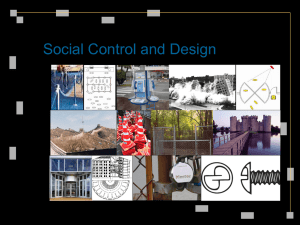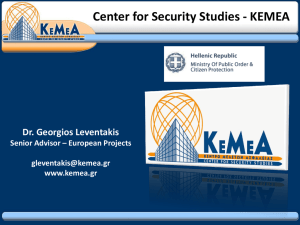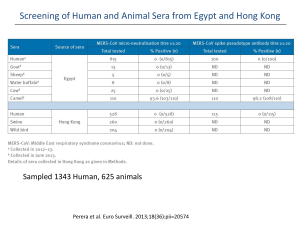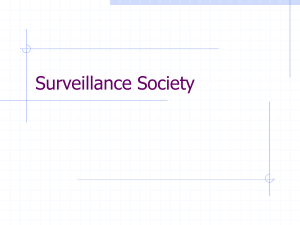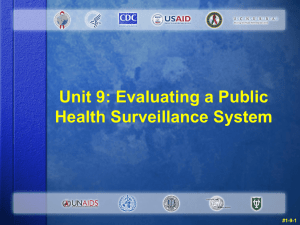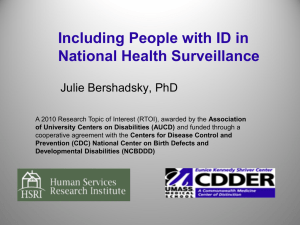leisure-time-surveillance-and
advertisement
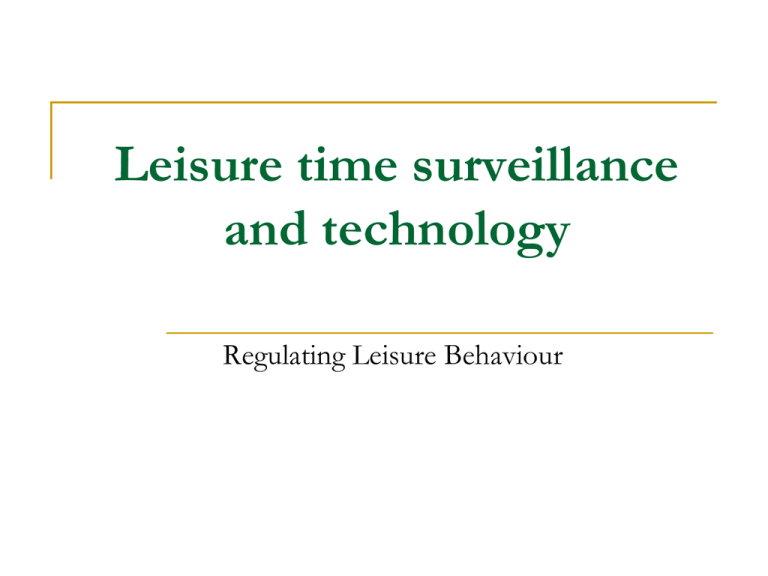
Leisure time surveillance and technology Regulating Leisure Behaviour Internalising the ‘gaze’ The theorisation of surveillance most commonly associated with the work of Michel Foucault (1977): He argued that surveillance constituted a new discipline of ‘norms’ and ‘behaviour’ Disciplinary power ‘produces’ disciplined obedience, as subjects learn to survey themselves, in effect becoming self-regulating The ultimate exercise of power is to make its exercise unnecessary Norris and Armstrong (1998) identify three types of power created by surveillance: 1. 2. 3. Direct, authoritative punishment (i.e. telling a ‘fan’ to sit down) Deterrence (I can be seen and identified) Abolition of potential for deviance (self regulation) Internalising the ‘gaze’ This is tied up with what Foucault saw as an escalation in the various forms of surveillance in the modern episteme, drawing on the work of Bentham and his Panopticon: Surveillance essentially enhances the ‘calculability’ of individuals, not by repressive control, but by extending their visibility (e.g. EPOS systems) For many, rather than been freed by technological advance, it has simply extended the reach of the ‘gaze’ into more and more areas of social life Lyon (2002) argues that numerous data (including biometric, genetic and video data) are abstracted from people and manipulated to create profiles and risk categories in a networked, rhizomatic system Surveillance works through ‘objectification’, ‘normalisation’ and leads to regulation through the construction of routine: ‘…its object, previously the goods possessed or produced by the subject, was now the subject himself, his daily rhythm, his time, his bodily actions, his mode of life…the power reached now towards the body and the soul of its subjects…it wished to regulate, to legislate, to tell the right from the wrong, the norm from deviance, the ought from the is…it wanted to impose one ubiquitous pattern of normality and eliminate everything and everybody which the patterns could not fit…’ (Bauman, 1982) Monitoring consumption The cultural industries have in place systems of surveillance which facilitate control of both consumers and producers Many of these systems emerged from either military practice or developed during Industrial Revolution They have as their raison d’etre the regulation of behaviour, often to facilitate the means of consumption Academic debate rages as to the determining effects of these systems vis-à-vis resistance (see Bryman, 2004) BUT: they can also be seen as a means of securing space for particular consumer groups (albeit in the process excluding others) The cultural industries also use the self-same technologies to construct a picture of the consumer and their specific tastes, which they then use to design an individualised offering: this is known as ‘customer relationship management’ (CRM) WATCHED OVER OR OVER-WATCHED? (Wilson & Sutton, 2004) Techno-control of consumers Disney epitomes of a consumption space where the ‘American Dream’ and its association with technological progress is played out (e.g. the Epcot Centre) Yet, conversely, these self-same technologies are employed to, i) restrict access and ii) regulate behaviour: Restricting access: CCTV cameras and two-way communication mechanisms allow employees to intervene to prevent ‘the underclass’ from gaining access to these secure leisure spaces Regulating behaviour: A ‘visible’ presence is complemented with an invisible presence to facilitate the internalization of particular norms of behaviour (e.g. direction of movement, noise, dress etc) This is emblemic of what Brymer (2004) calls a Disneyization of Society: where these control systems extend from their originator (Disney) to a plethora of sites Techno-control of consumers The gaze on our consumption is all-pervasive and omnipresent: Our calls are recorded…our credit cards betray our consumption patterns…these patterns are collated on global databases into which interested parties invest in order to access our consumption blueprints…even our interaction with television tells them about what we are like – they have an avenue into our minds, all facilitated by technological advance The essential principle of the disciplinary consumer paradigm is that we internalise/conform to the rules of consumption without the need for repressive action Technologies also facilitate standardization (see Lecture 2) so that we all enjoy a similar experience (e.g. theme park rides) Surveillance is now ‘an everyday experience, run by a myriad of agencies for multiple purposes and exempting no one’ (Lyon, 2002) (e.g. Enemy of the State, Brazil) Techno-control of consumers (2) Public leisure spaces as sites for overt and covert surveillance As we celebrate the urban entertainment nightscape we are watched by a regime of surveillance. In malls, Willis (1995) argues that we “are in an environment where there is probably more surveillance per square inch than in any of today’s underfunded public prisons”. But what about in the outdoors or as we watch sport? Surveillance is justified on the prevention of crime and security: it’s for your own safety (e.g. Minority Report) Lighting the cityscape: enhancing visibility or an aestheticising process? What about theories of displacement (Lyon, 2000): merely moving the problem elsewhere whilst sanitizing and gentrifying city centre spaces Surveillance in and around sport stadia: regulate ‘inappropriate’ behaviour (albeit, in the process, alienating the ‘traditional’ fan base) Online surveillance: email and internet usage (our leisure choices are visible and often judged by law as ‘illegal leisure’) Global Positioning Systems: an enhancement of safety/security or a technological tag? Techno-control of leisure workers As employees ‘perform’ their labour, they are increasing being monitored: Call centres: performance efficiency/effectiveness recorded CCTV: initially to secure space, but now to spy on employee performance (the leaky container phenomenon) New key controlled till systems whereby each employee has their own ‘key’ which allows them to ring up an order. In the process, the individual is made visible and aware of the ‘gaze’ upon their every action The problems is that, especially for the service encounter, this monitoring can affect the way in which employees interact with the customer. Inflexible systems can lead to customer frustration as the ‘system’ is blamed for the poor quality of customer service It also has an effect on notions of ‘trust’ and ‘loyalty within work situations Can also lead to the replacement of workers with machines, because the machine never lies… The future…? Societies ‘obsessed with security’ (Gray, 2003) Facial recognition systems (e.g. Minority Report): our biological password But these systems potentially alter our sense of social consciousness: Not only can we use cameras to see, but also to recognise and ‘warn’ “Electronic means have more and more often been used to replace informal social control in an urban environment; the eyes of the people on the street are replaced by the eyes of surveillance cameras” (Koskela, 2002: 259) “public spaces will increasingly be replaced by pseudo-public spaces like those in shopping malls, where commercial imperatives dominate and what goes on, and who participates, is intensely regulated and tightly-controlled so that profitable consumption is maximised (McCahill, 1998: 52) The ‘problem’ or ‘threat’ is often teenagers, the homeless, or any other ‘low value’ set of consumers. In short, anyone who threatens the smooth operation of the means of consumption Key questions In analysing the pervasive nature of surveillance in our lives, do you see it as a dark evil or an emancipatory force? Given the focus of this module, how can surveillance be utilised by producers, consumers and regulators to influence behaviour? How can we make judgements about the appropriate level of surveillance in our everyday lives? Does this depend upon our position in the social system? References Foucault, M (1977) Discipline and Punish http://www.cartome.org/foucault. htm) Lyon, D (1993) The Electronic Eye: The Rise of Surveillance Society Lyon, D (2002) ‘Everyday Surveillance: Personal data and social classifications’, Information, Communication and Society, 5 (2): 242-257 Dandeker, C (1990) Surveillance, Power and Modernity: bureaucracy and discipline, Polity Press Koskela, H (2000) 'The gaze without eyes': video-surveillance and the changing nature of urban space’, Progress in Human Geography, 24 (2): 243-265

